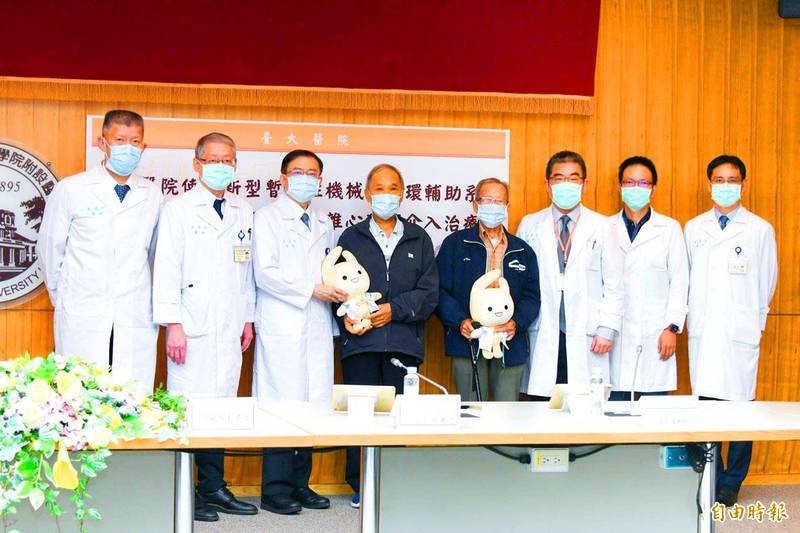《TAIPEI TIMES》New procedure an option for heart patients

National Taiwan University Hospital doctors pose for a photograph during a news conference yesterday at the hospital where they announced successful percutaneous coronary interventions on two complex higher-risk and indicated patients. Photo: Chiu Chih-jou, Taipei Times
MINIMALLY INVASIVE: A new procedure using a percutaneous micro-axial left ventricular assist device was used to treat two high-risk elderly patients, NTUH said
By Lee I-chia / Staff reporter
National Taiwan University Hospital (NTUH) yesterday reported that it had performed percutaneous coronary interventions with a new temporary mechanical circulatory support (TCS) device on two patients with severe coronary artery disease — marking the first two successful cases in Taiwan.
NTUH Division of Cardiology assistant professor Huang Ching-chang (黃慶昌) said it has been tricky to treat people with serious complex coronary artery disease and severely depressed left ventricular function, because the best treatment option is a coronary bypass, which might not be suitable for some elderly patients or patients with multiple comorbidities.
Percutaneous coronary intervention is an option for such people, he said.
While it is a minimally invasive procedure and allows for faster recovery, there are still risks of complications, such as hemodynamic instability and cardiac arrest, and that due to the high risks, doctors can often only deal with the most serious symptoms, Huang added.
Many specialists around the world have suggested that TCS devices can be used on complex higher-risk and indicated patients during percutaneous coronary interventions to avoid acute cardiac arrest or other serious complications during the procedure, he said.
Common TCS devices include an intra-aortic balloon pump, which has weaker circulatory support and might not be helpful to patients with high risk of serious complications, and extracorporeal membrane oxygenation, which has a higher risk of complications and might increase the burden on the left ventricle.
The NTUH introduced a new percutaneous micro-axial left ventricular assist device, which is a catheter-mounted axial-flow pump that can be inserted in the femoral artery and enters the left ventricle, providing hemodynamic support in high-risk procedures and reducing complications.
It performed its first two successful operations on Oct. 18. One of the patients is a man in his 70s, surnamed Kao (高), who had high blood pressure and cholesterol levels, and difficulty breathing. He was diagnosed with left ventricular enlargement, coronary artery calcification and stenosis, and left circumflex artery blockage.
Kao said he was afraid of getting a coronary bypass, but agreed to the percutaneous coronary intervention procedure.
He said he was surprised he could get out of bed and walk the following day, and can now walk to a nearby market without having to stop three times to rest liked he used to.
The other patient is a man in his 90s, surnamed Huang (黃), who has high blood pressure and cholesterol levels, as well as chronic kidney disease.
He had been hospitalized three times for acute heart failure in four months.
Huang said he used to need to rest several times when climbing the stairs to his second-floor apartment.
He said he has since recovered about 90 percent and no longer has difficulty breathing when climbing stairs.
新聞來源:TAIPEI TIMES
















